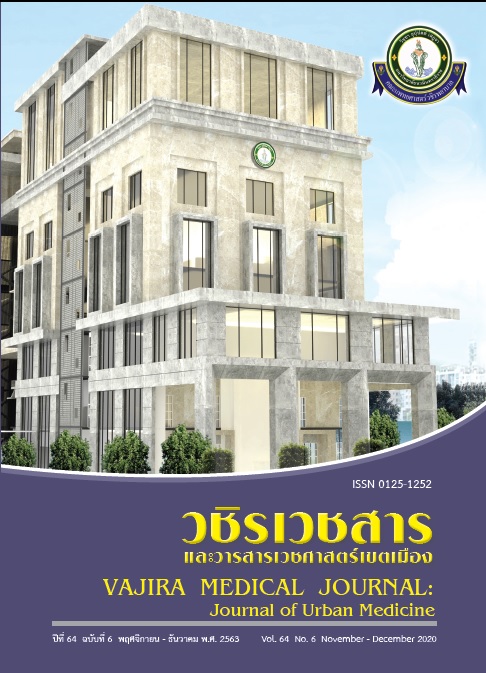Acute Ischemic Stroke Prevention Among Smoking Workers in the Urban Establishment
Main Article Content
Abstract
The workers have important role for establishing a stable family and developing a country’s economic system. Healthy workers increase the ability of working performance, and thus, stable income growth that can improve their quality of life. On the other hand, workers who have severe health problems can have early morbidity or mortality including ischemic stroke. This is an emergent group of insufficient blood flow to the brain which is called “Acute ischemic stroke” is an emergent condition of insufficient blood flow to the brain.1,12,15 Several causes can lead to acute stroke, including diabetes mellitus, hypertension, hyperlipidemia, lack of exercise, inappropriate consumption, usage of contraceptive pill, and smoking. Previous studies showed that the highest rate of smokers was in the working population aged between 15-59 years old. The risk of ischemicstroke was higher in that particular population when compared to other groups, who were not smoking.2,7,13 Specially, concerns are made to the workers who are smoking in the area of urban. This could result in higher risk of acute ischemic stroke.4,5,8,11,16 Therefore, the occupational healthnurse plays important roles to ensure the proactive health promotion among smoking workers for preventing acute ischemic stroke. The occupational health nurses should focus on providing knowledge and special counseling about smoking cessation for smoking workers so that they can practice the effective behavior changing techniques in smoking cessation.
Downloads
Article Details
References
Amarenco P. Transient Ischemic Attack. N Engl J Med 2020;382(20):1933–41.
Abdolahi A, Williams GC, Benesch CG, Wang HZ, Spitzer EM, Scott BE, et al. Smoking cessation behaviors three months following acute insular damage from stroke. Addictive Behaviors 2015;51:24–30.
Choi S, Chang J, Kim K, Kim SM, Koo H-Y, Cho MH, et al. Association of smoking cessation after atrial fibrillation diagnosis on the risk of cardiovascular disease: a cohort study of South Korean men. BMC Public Health 2020;20(1):1–8.
Cheewaphongphan P, Junpen A, Garivait S, Chatani S. Emission Inventory of On-Road Transport in Bangkok Metropolitan Region (BMR) Development during 2007 to 2015 Using the GAINS Model. Atmosphere 2017;8(9):167.
Fisher JA, Puett RC, Laden F, Wellenius GA, Sapkota A, Liao D, et al. Case-crossover analysis of short-term particulate matter exposures and stroke in the health professionals follow-up study. Environment International 2019;124:153–60.
Kerdklinhom J, Oumtanee A. Roles of an Occupational Health Nurse. JRTAN 2018;19:137–146.
Kim D-E, Lee K-B, Jang I-M, Roh H, Ahn M-Y, Lee J. Associations of cigarette smoking with intracranial atherosclerosis in the patients with acute ischemic stroke. Clin Neurol Neurosurg 2012;114(9):1243–7.
Kumagai N, Okuhara Y, Iiyama T,Fujimoto Y, Takekawa H, Origasa H, et al. Effects of smoking on outcomes after acute atherothrombotic stroke in Japanese men. J Neurol Sci 2013;335(1/2):164–8.
Pender NJ, Murdaugh CL, & Parsons MA. Health promotion in nursing practice.6thed. Upper Saddle River: NJ: Pearson Prentice Hall;2011.
Pacheco SA, Aguiar F, Ruivo P, Proença MC, Sekera M, Penque D, et al. Occupational Exposure to Environmental Tobacco Smoke: A Study in Lisbon Restaurants. J TOXICOL ENVIRON HEALTH PART A 2012;75(13–15):857–66.
Tian Y, Liu H, Zhao Z, Xiang X, Li M, Juan J, et al. Association between ambient air pollution and daily hospital admissions for ischemic stroke: A nationwide time-series analysis. PLoS Medicine; 15(10):1–16.
Wood D. Ischemic Stroke. Health Library: Evidence-Based Information [Internet]. 2018 [cited 2020 Feb 28]. Available from: http://search.ebscohost.com.ejournal.mahidol.ac.th/login.aspx? direct=true&db=nup&AN=2009866388&site=eds-live.
Wang S, Chen J, Wang Y, Yang Y, Zhang D, Liu C, et al. Cigarette Smoking Is Negatively Associated with the Prevalence of Type 2 Diabetes in Middle-Aged Men with Normal Weight but Positively Associated with Stroke in Men. J Diabetes Res 2019;1–8.
Wang Z, Cui R, Wang K. Smoking and drinking influence the advancing of ischemic stroke disease by targeting PTGS2 and TNFAIP3. Exp Ther Med 2018;15(3):2818–23.
You RX, Thrift AG, McNeil JJ, Davis SM, Donnan GA. Ischemic Stroke Risk and Passive Exposure to Spouses’ Cigarette Smoking. Am J Public Health 1999;89(4):572–5.
Yuan S, Wang J, Jiang Q, He Z, Huang Y, Li Z, et al. Long-term exposure to PM2.5 and stroke:A systematic review and meta-analysis of cohort studies. Environ Res 2019;177:N.PAG.
Zhang P, Guo Z-N, Sun X, Zhao Y, Yang Y. Meta-analysis of the Smoker’s Paradox in Acute Ischemic Stroke Patients Receiving Intravenous Thrombolysis or Endovascular Treatment. Nicotine Tob Res 2019;21(9):1181–8.
Thai College of Emergency Physicians. Guidelines for treatment and thrombolytic drugs for acute ischemic stroke outside the hospital and emergency room in 2020.2020 [cited 2020 June 12]. Available from: http://www.tceps.org/tcep1/
The Heart Association Of Thailand Under The Royal Patronage of H.M. The King. Practical guidelines for the care of patients with atrial fibrillation (AF) in Thailand. 2020 [cited 2020 June 12]. Available from:http://www.thaiheart.org/images/column_1291454908/Thai_AF_Guideline_2012.pdf


